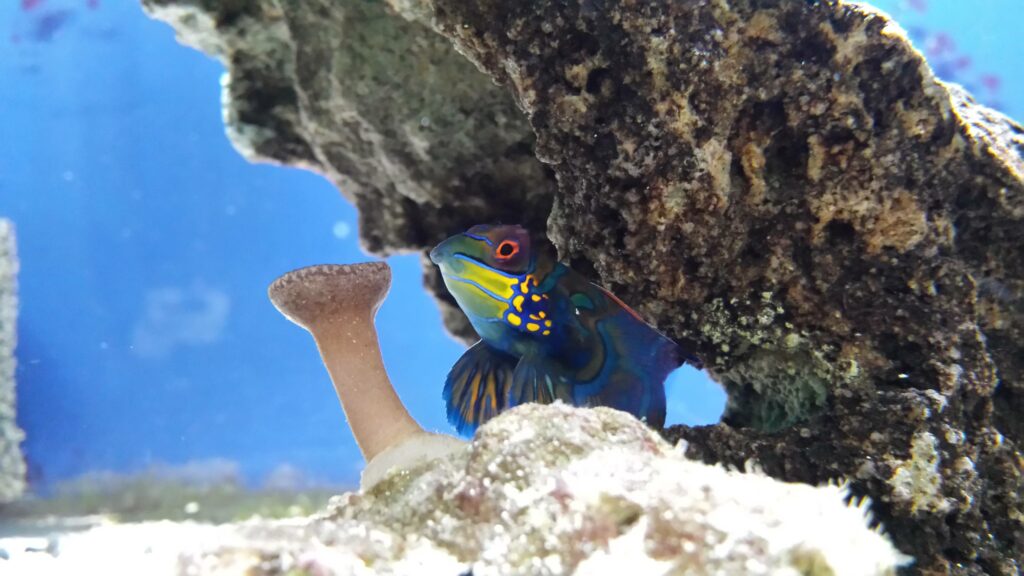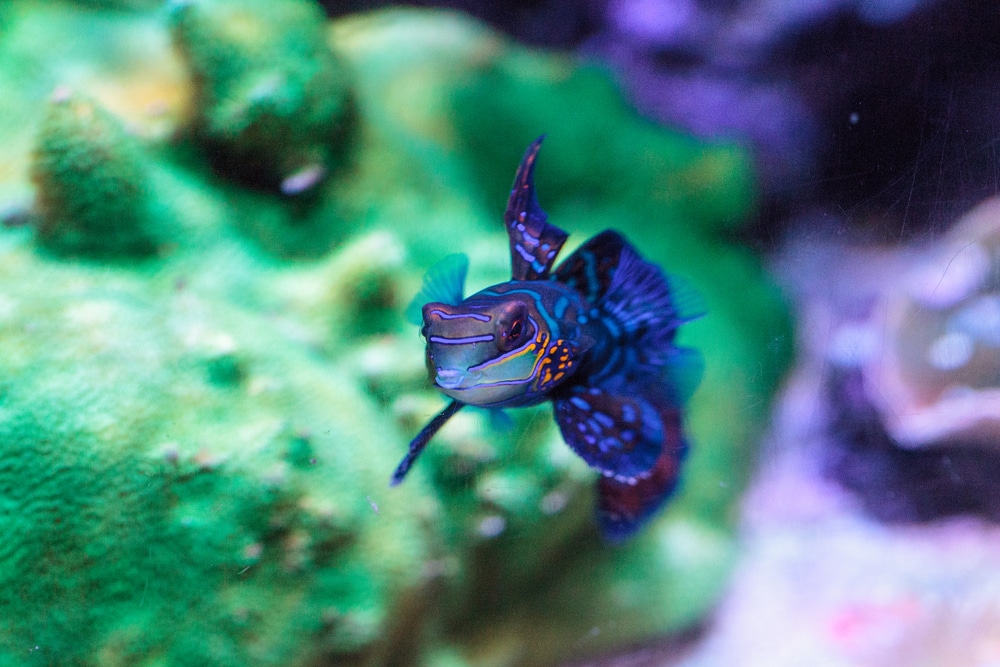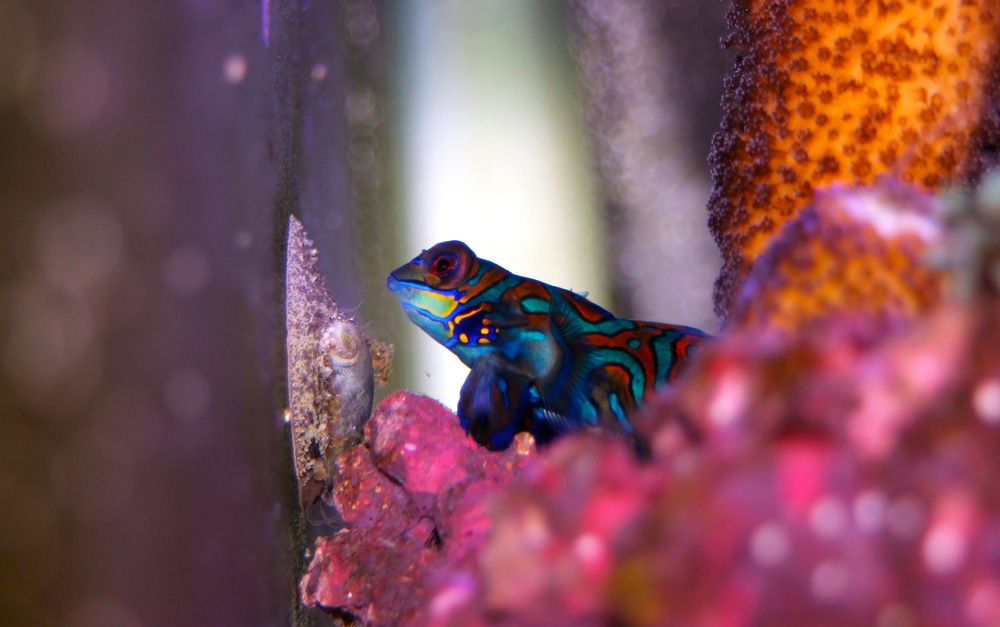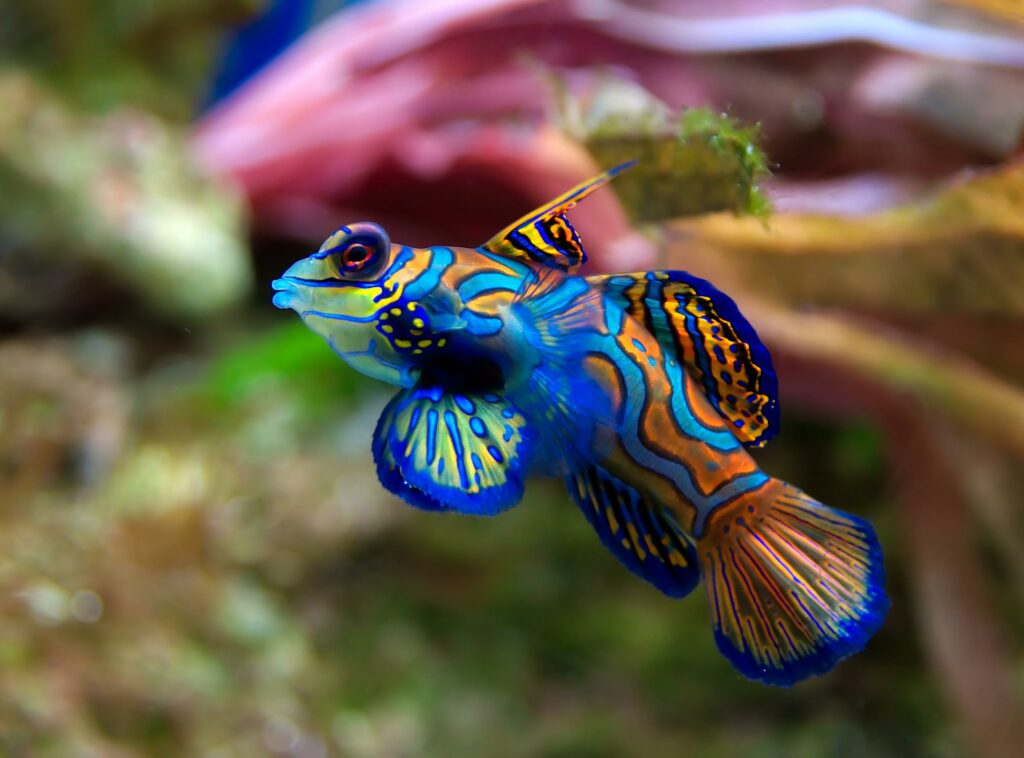Mandarin Dragonets are in the running for the most colorful fish on the reef, which is impressive given the staggering number of beautiful fish out there. Their colors are psychedelic in intensity, with vibrant tones that are never boring to examine.

There are actually two species in the hobby; the more common Mandarin Dragonet (Synchiropus splendidus) and its cousin the Picturesque Dragonet (Synchiropus picturatus). The Picturesque Dragonet is very different in appearance, with large spots against a green background rather than a striped pattern. That said they have identical care requirements to their more vibrant cousins!
Despite being small, slow, and easy to see, the Mandarin Dragonet is not without defenses. In fact, the loud colors are actually a form of aposematism, where an animal actively signals to predators “I’m here and you don’t want to eat me.”
In this case, the Mandarin fish is covered in foul, toxic slime that makes it an unappealing mouthful for any fish that tries to have a taste. It’s smelly enough that even marine biologists working with them notice the smell easily.
What are Mandarin Gobies?
The Mandarin Goby is one of the strangest fish in the sea. You can tell right away by simply looking at it. It’s a mishmash of clashing colors that are garish even by saltwater standards.
Despite being brilliantly colored and easy to see the Mandarin Goby is a slow, creeping fish. Often it perches right on coral frags but spends most of its time poking around in between rocks and coral. How does such a slow, helpless, obvious fish avoid being a meal?
The bold color of the Mandarin Goby is actually a warning flag. Much like bees, monarch butterflies, coral snakes, and other dangerous animals, the Goby is advertising its presence to predators, telling it to watch out. I’m not scared of you but you should be scared of me.
The skin of the Mandarin Goby is coated in a toxic slime that tastes bitter. In fact, it’s so noxious that it can kill nearby fish if exposed for a long time. When moving Mandarin Gobies to a new home, never bag them with other fish. They may become fatally poisoned within minutes by the slime cocoon the Goby releases under stress.
Both the Mandarin Goby and its cousin the Picturesque Dragonet (Synchiropus picturatus) are very interesting for another, even less well known reason. They are two of the only vertebrates (among a handful of all animals) that are truly blue in color.
But wait, you say, thinking of blue butterflies, birds, and fish. As it turns out, blue pigmentation involves a complex and rare evolutionary pathway. Every other animal that evolved blue color does so through trickery.
Typically they use structural components within their scales or feathers to bend white light in such a way that blue wavelengths are reflected back. Mandarin Gobies, on the other hand, have true blue pigments!
You may also come across a Red Mandarin Goby, which is a variant of the standard breed but is the same species. What interesting little fish! So how does one go about caring for a Mandarin Goby?
- Common Names: Mandarin Goby, Red Mandarin Goby, Green Mandarin Dragonet, Psychedelic Dragonet, Mandarinfish
- Scientific Name: Synchiropus splendidus
- Origin: Western Pacific Ocean
- Length: 3 inches
- Aquarium Size: 20+ Gallons
- Temperament: Peaceful; Shy
- Ease of Care: Moderate to Difficult

Mandarin Goby Care
As beautiful as these little fish are, there’s a fair amount to be aware of when keeping them. Mandarin Gobies aren’t a good first fish for anyone and are a challenge even for experienced aquarists.
Aquarium Size & Selecting Your Goby
These stunning little fish place no demands on you when it comes to space requirements. Mandarin Gobies can live comfortably in aquariums as small as 20 gallons. Large, mature aquariums are better for them because they are more likely to grow a sustainable crop of crustaceans and worms for your Goby to feed on.
In a large enough, well established tank, you may never need to worry about feeding your Goby at all. It may simply graze continuously on the invertebrates living in and around live rock. This is by far the best possible way to care for a Mandarin Goby.
When shopping for a Mandarin Goby it’s not as simple as pointing to the tank and taking your fish home. Take the time to examine the Goby closely because they are all wild-caught and are fairly sensitive fish.
If the Mandarin Goby is pale in color and has a visible bony ridge protruding from their sides, they are starving. The Goby may only have just arrived and may bulk up in a couple of weeks. But they are also notoriously picky eaters, which we will discuss in much greater detail. And like most marine animals they probably have some internal parasites that are making things worse for them.
Unfortunately, Mandarin Gobies are also very likely to be collected by poisoning. In many parts of the world fisherman load cyanide into spray bottles and mist the reef. This briefly stuns the fish, making them simple to catch and bag.
However cyanide is deadly poisonous and the fish may have long-term effects that don’t manifest until after they make it to your aquarium, weeks down the line. If your Goby doesn’t look perfect don’t buy it.
Also ask to watch it feed and hold off from buying it if it refuses as these fish eat constantly. Unless you’re willing to take the time to try and train it onto a particular food source, you’re better off waiting for a healthy specimen to arrive or buying from a Mandarin Goby specialist.
Water Conditions for Mandarin Gobies
Mandarin Gobies are not especially sensitive nor are they as hardy as Damselfish and other fish better suited to beginning aquarists. Your water conditions should remain as close to marine standard as possible. That means temperatures of 72-82℉ and a pH of 7.9-8.4. As long as you are using a heater and a proper coral aragonite substrate this should be easy to achieve!
Ammonia, nitrite, and nitrate levels should be at or close to 0 parts per million. A little nitrate is fine since it’s often used as a nutrient for the symbiotic algae living inside coral cells. But ammonia and nitrite should stay close to 0 ppm.
What’s most important for the majority of reef animals is stability. Fluctuating water parameters causes them stress because they come from an environment where water conditions take tens of thousands of years to meaningfully shift. Since aquariums are much smaller environments where an overfeeding or chemical overdose can cause immediate changes, saltwater tanks tend to be a little more difficult than freshwater one.
Are Mandarin Gobies Reef-Safe?
Yes, in fact, Mandarin Dragonets are some of the most popular additions to coral reef tanks. They are entirely peaceful, ignoring or avoiding all of their tank mates. Mandarin fish ignore corals, anemones, feather duster worms and other inhabitants, spending all of their time hunting for copepods, gammarus, tiny worms, and other prey items.
In fact, I’d go so far as to say a reef tank is the best environment to keep one in. Reef tanks are very biodiverse thanks to the different animals, algae, and loads of live rock.
This gives you a much easier time of growing the crustaceans that Mandarin Gobies feed on. In a fish-only tank you’re not going to have very many of these animals since your other fish will find them tasty and there are fewer hiding places for them.
Feeding Mandarin Gobies

Understanding how to feed Mandarin Gobies is by far the most important aspect of keeping them healthy. These fish are very challenging to keep fed because they have a specialized diet and niche they occupy in nature.
In the wild, Mandarin Gobies spend all of their time hunting in between coral fragments looking for small crustaceans and worms. But above all, they prefer copepods and gammarus, tiny crawling and free-swimming crustaceans that are an important part of the marine food chain.
These crustaceans aren’t difficult to grow and breed but in most aquariums the filtration unit does too good of a job. It will suck up and free-swimming copepods or their larvae. And a clean aquarium may not have enough detritus to maintain a large population of crustaceans long-term.
Mandarin Gobies are also grazers rather than meal takers. Throughout the day they hunt and eat these tiny invertebrates. Since they have a formidable appetite and are always hungry the supply needs to be nearly constant. Or you simply feed them regularly.
The final challenge is that they are shy bottom dwellers and refuse to dash about for food like other fish. Your Mandarin Goby will be outcompeted for food at every opportunity. Assuming you even offer them their favored prey they may end up starving due to their lack of speed…
Mandarin Gobies are entirely wild-caught so training them to accept prepared foods like flakes or pellets is next to impossible. They tend to starve before learning these items are edible. Many aquarists have success feeding them live Mysis or Brine Shrimp, which can be easily cultured at home. Eventually, you may be able to wean them onto frozen shrimp, making things even easier for you!
But if you’re worried about your Mandarin Goby’s long-term health, raising Copepods or Gammarus yourself is the best way to succeed with these fish. Copepods can be raised in separate aquariums and be fed green water planktonic algae. The Copepods will multiply rapidly and can be used as a continuous food source for your Mandarin Goby!
Gammarus are also worth exploring. These tiny crustaceans prefer crawling to swimming and can be found in nearly any established marine aquarium. However your Mandarin Goby will likely eat all of them unless you have a large (55+ gallon) mature reef aquarium where the gammarus population can remain stable.
If you have a refugium set up for your aquarium it’s also a perfect location to raise gammarus. Free from predation from all of your fish and with plenty of macro algae and detritus to fuel their growth, you can have a ready supply of live food as well as a capable biological filter.
Once you’ve secured your food source, you may need to take special care to feed your Mandarin Goby. A pipette or small netful of crustaceans can be offered to them directly. This keeps their food from being entirely eaten by other fish and swept up into the filter before the Goby gets a chance to eat.
But these fish are moody and may simply flee if they see your giant hand coming towards them. You’ll have to get creative when feeding these fish. I recommend buying Mandarin Gobies that will eat in the store in front of you.
Or you can buy directly from distributors that know the challenges involved in raising these fish. Some distributors take the time to wean them onto mysis shrimp before selling them, which makes things much easier for you.
Tank Mates for Mandarin Gobies
Since Mandarin Gobies aren’t very competitive during feeding time it is a good idea to choose tank mates that won’t frighten them away from feeding. A few good options include other bottom dwellers with slow eating habits, such as Firefish and true Gobies. Just watch for aggression from either your Mandarin Goby or other bottom dwellers.

Since these fish rely on a very limited source of food they will sometimes chase away others they perceive as rivals. Usually that’s only the case if a fish looks similar to a related species but not always.
Choose tank mates that won’t act aggressively or territorially towards your Mandarin Goby since these poor fish have a tendency to bumble into the zones claimed by other fish. Tangs, Pygmy Angelfish, Chromis Damselfish, and Clownfish make great choices. Just be aware of which species you’re looking at since many larger Clownfish, Damselfish, and Angelfish are more aggressive than their smaller relatives. Coral Beauty and Flame Angelfish have complementary colors and habits to Mandarin fish.
Mandarin Gobies are also safe alongside any invertebrates you care to keep, including sea anemones, soft corals, large polyp stony, and small polyp stony corals. They don’t pick at corals at all but be careful not to choose species with especially powerful stings, such as carpet anemones. A single blunder into the tentacles of one of these could prove fatal.
Shrimp, snails, starfish, and giant clams are all safe with them as well. Just stay away from crabs. Since Mandarin fish roam along the substrate they will come into contact with these opportunistic predators too often and may end up a meal for one if the goby is weak or caught by surprise.
Good Tank Mates for Mandarin Fish:
- Tangs, Pygmy Angelfish, peaceful Damselfish, Clownfish, and other Marine Community Fish
- Shrimp, Snails, Clams, Starfish, Feather Duster Worms, and other Invertebrates
- Soft, LPS, and SPS Corals, and Sea Anemones
Poor Tank Mates for Mandarin Fish:
- Aggressive eaters, territorial fish
- Crabs and other predatory bottom dwellers
How Do I Breed Mandarin Fish?
Assuming you can provide for their challenging care requirements, breeding them is difficult but not impossible! Mandarin Gobies do have faint differences between the males and females; they are sexually dimorphic. Males will be noticeably larger than females of the same age. They also have a long dorsal fin extension that will be held erect during territorial spats and courtship displays.
The other complication to spawning them in captivity is that they seek out bare patches of ground to be more visible to potential mates at dawn and dusk, where predators will have a harder time seeing them.
Potential female partners arrive to watch the dancing males, eventually selecting one to mate with. The pair then perform an intricate dance, rising up into the water column to release their eggs and sperm. Once they do so they quickly dash back to the safety of the reef.
The fertilized eggs will then drift along the currents that wash over the reefs, developing and hatching into larval Mandarin fish that feed on the planktonic organisms that grow alongside them. Once they reach a certain size they fall to the bottom and become foraging Mandarin Gobies.
This floating larval stage is another reason why breeding Mandarin Dragonets in captivity is so difficult. In most fish tanks these young would simply be sucked up into your filter or protein skimmer. Or your corals, fish, and other tank mates would simply eat the eggs and babies. But if you were to create a dedicated system for Mandarin Dragonets breeding them would not be impossible to achieve!
Frequently Asked Questions on Mandarin Gobies
Yes, they are! That said, their poison is only dangerous to fish that try to eat them. It’s rarely fatal even then, just foul in taste and smell.
The Mandarin Goby is not a true goby. It has the same habits and appearance as one but they actually belong to their own family (Callionymidae).
If you are worried that your Mandarin Goby won’t adapt quickly to whatever food you have to offer then yes. By quarantining a fish you can ensure that it has no competition for food, check it over for parasites, and keep it separate if it suddenly develops a disease.
Mandarin fish aren’t terribly expensive for such beautiful aquarium residents. A single adult Mandarin Goby costs $25-50!

